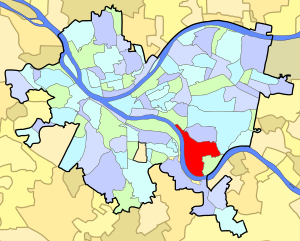Hazelwood (Pittsburgh)
| Hazelwood | |
|---|---|
| Neighborhood of Pittsburgh | |

The John Woods House, built in 1792, is perhaps the oldest house in the city of Pittsburgh.
|
|
 |
|
| Coordinates: 40°24′32″N 79°56′28″W / 40.409°N 79.941°W | |
| Country | United States |
| State | Pennsylvania |
| County | Allegheny County |
| City | Pittsburgh |
| Area | |
| • Total | 1.583 sq mi (4.10 km2) |
| Population (2010) | |
| • Total | 4,317 |
| • Density | 2,700/sq mi (1,100/km2) |
|
|
Hazelwood is a neighborhood of Pittsburgh, Pennsylvania in the United States. It is represented on Pittsburgh City Council by Corey O'Connor. It is bordered by Greenfield and Oakland on the north, Squirrel Hill and Glen Hazel on the east, and the Monongahela River on the south and west. The Pittsburgh Bureau of Fire houses 13 Engine and 13 Truck in Hazelwood.
In 1758 a large tract of woodland was purchased for $10,000 under the Stanwix Treaty made with the Native-Americans. This area would include Hazelwood and Greenfield of the 15th ward.
Hazelwood takes its name from the hazelnut trees which once flourished along the Monongahela river. The first settlers were of Scottish descent and settled what was known as Scotch Bottom. This area ran from Four Mile Run (lower Greenfield) to Six Mile Ferry, four and six miles (10 km) from the Point (where the Allegheny and Monongahela Rivers merge) respectively. Among the first settlers was John Woods, a politician who built his 'Hazel Hill' estate in 1784. That house still stands, the second oldest stone building in Pittsburgh after The Fort Pitt Blockhouse. Eventually, large farms were cut out of the wooded hills, attracting more residents and supplying the area with further wealth.
The first track of railroad was built by Mr. B. F. Jones, of the Pittsburgh and Connellsville Railroad and later of Jones and Laughlin. Unlike most lines, this railroad was built inland as to respect the residents concern of maintaining the river's aesthetic value. This railroad would later separate Hazelwood into two sections, coining the local term 'below the tracks'. In 1869 Hazelwood was incorporated into the city, and by the following year the railway had spurred iron and steel industries, railroading, boatbuilding and the river trade.
...
Wikipedia
